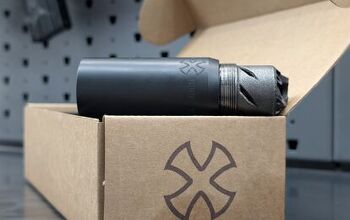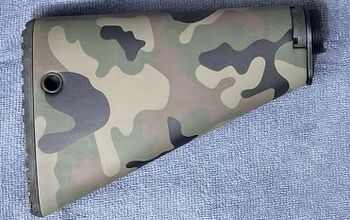Russian Smart Scope System - Their Answer To The XM157

There have been numerous efforts to enhance hit probability through mechanical improvements and advancements in ballistics. A key innovation is an electronic automated control system. In January 2025, Russia patented an electronic automated fire control system for small arms, filed by Kalashnikov Concern. A mock-up of this concept was first publicly showcased in 2023. This automated control system is designed for the AK-12 and the future GPR-20 under-barrel rocket launchers. This may be a development to counter the new US Army’s new Vortex Optics XM-157 Next Generation Squad Weapon-Fire Control (NGSW-FC) or, more ambitiously, the XM29 Objective Individual Combat Weapon (OICW).
The latest Russian smart scope system features a hybrid electronic automated fire control system that combines advanced technologies to reduce human error and enhance weapon precision and soldier lethality. This smart scope integrates a digital display, laser range finder, thermal imaging, image recognition, ballistics calculator, atmospheric sensors, and a compass. It adjusts the ballistics profile based on current atmospheric conditions to improve the likelihood of hitting a target on the first shot. This definitely sounds like a development influenced by the XM157.
This new optic enables soldiers to engage targets quickly and accurately at a distance, eliminating the skill factor and human error of the aiming and the shot process. The idea behind this system is that it has the potential to transform every soldier into an expert marksman instantly, without the need for difficult, expensive, and time-consuming additional training, which most armies have a difficult time facilitating enough training and range time. This approach seems practical, especially for a conscript army, at least on paper.
The system
The hybrid electronic automated fire control system is equipped with a rangefinder, image recognition, digital display, and thermal imaging, all interconnected through a communication interface. Its design includes an optical device with sensors allowing for automated firing based on sight signals. The patent does not specify the sight magnification.
This sighting system is designed for the AK-12 assault rifle and GPR-20 under-barrel rocket launcher and offers automated firing options for both. The rangefinder includes a ballistic calculator, information display, atmospheric sensors, and a system to determine the weapon's position. The weapon's location is established by determining its position relative to the target using an inclinometer sensor, electronic gyroscope, accelerometer, or magnetometer.
The image recognition module comes with an integrated information display. The trigger mechanism is an electric drive, while the power supply module includes a control system. The image recognition module identifies targets by utilizing data from the rangefinder and imaging modules, marking the target area on the display. Users can adjust firing modes, allowing options such as fuse selection and both automated and manual firing modes, which indicate compatibility with future programmable GRP-20 grenades. AK rifles aren’t known for the best triggers, but this may make it more interesting as the system tracks the position of the trigger.
The calculations demonstrate that the automated firing mode enhances shooting effectiveness by minimizing or eliminating errors and facilitating automatic target recognition and firing procedures. “As a result, the likelihood of hitting the target with the first shot at a range of 300 meters increases by 1.6 times for head targets and 1.4 times for chest targets.”
The system includes a 5-minute internal battery backup, with the primary battery located in the rifle stock; the runtime is not specified. The fire control system is designed to allow for the addition or removal of modules. With additional communication interfaces, the scope can update to newer software and keep up to date with the newest evolving threats.
The patent describes a soldier equipped with a display but doesn’t provide specific details. This display could range from a simple chest-mounted unit to a helmet-mounted one, similar to the U.S. Army’s Integrated Visual Augmentation System. Such a setup would enable Russian soldiers to use a helmet-mounted system to see through the scope without directly looking through the optic. By integrating this technology, soldiers could fire their weapons behind cover while positioning them around obstacles. This time, actually seeing what they are shooting at.
Conclusion
Implementing a hybrid automated fire system can significantly enhance weapon accuracy and soldier effectiveness on the battlefield. These technologies improve the speed of target acquisition, increase accuracy through precise measurements, enhance situational awareness, and reduce cognitive load during engagements. Collectively, they represent a substantial shift in Russian military doctrine and technology.
The Russo-Ukraine War has accelerated the transfer of battlefield technology within Russia, which will help close the technological gap in the future. Given its global implications, it raises the question: will all the components be of Russian origin, or will foreign processors and electronic sub-components be utilized? This consideration leads to potential supply shortages and increased reliance on foreign suppliers.
Lastly, what scale will this sighting system be developed for? It is likely intended for the future Ratnik program. While technology can enhance capabilities, it cannot replace the need for proper training, which applies to all military forces. To improve soldiers' shooting skills, it is essential to return to the basics and first master the fundamentals before incorporating advanced technologies. This is particularly important because technology can fail or underperform, which is common in the military, necessitating a return to basic skills. This is where the XM157 features an etched reticle designed for use if the system malfunctions. This technology could significantly enhance their combat effectiveness if the Russian smart scope is deployed at scale. However, we must wait for further information to be released on its development, and I will follow up as it progresses.

Lynndon Schooler is an open-source weapons intelligence professional with a background as an infantryman in the US Army. His experience includes working as a gunsmith and production manager in firearm manufacturing, as well as serving as an armorer, consultant, and instructor in nonstandard weapons. His articles have been published in Small Arms Review and the Small Arms Defence Journal. https://www.instagram.com/lynndons
More by Lynndon Schooler
















![[SHOT 2025] A Closer Look At The 7mm Backcountry](https://cdn-fastly.thefirearmblog.com/media/2025/01/22/02265/shot-2025-a-closer-look-at-the-7mm-backcountry.jpg?size=350x220)











Comments
Join the conversation
It’s fine to shoot for the stars but this is Russia. They might be able to build a few prototypes but mass production? A few hundred might be fine for SOF units but the strength of the XM157 isn’t that it could do but what it will do in numbers. Even if you think the XM7 is doomed the XM157 can still be mounted on M4 and M110A1.
Mounts directly to the dust cover?